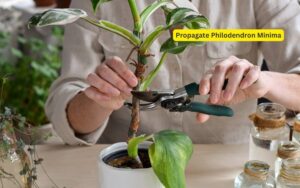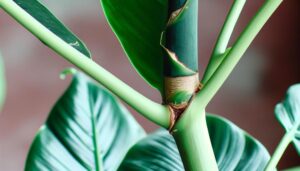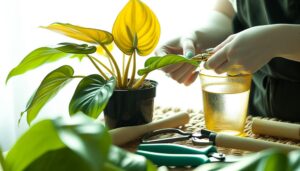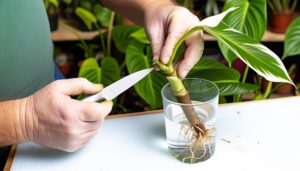How to Propagate Philodendron Philodendron Mello-Barreto Anum?
To propagate Philodendron Mello-Barreto Anum, select a healthy stem cutting with at least two nodes during its active growth period. Use sterilized cutting tools to make a clean cut just below a node.
Dip the cut end in rooting hormone and let it dry for a few hours. Plant the cutting in well-draining potting mix and keep the soil consistently moist.
Provide bright, indirect light and moderate humidity levels. This careful methodology promotes peak root development and healthy growth.
For detailed steps and additional care guidelines, further exploration is essential.
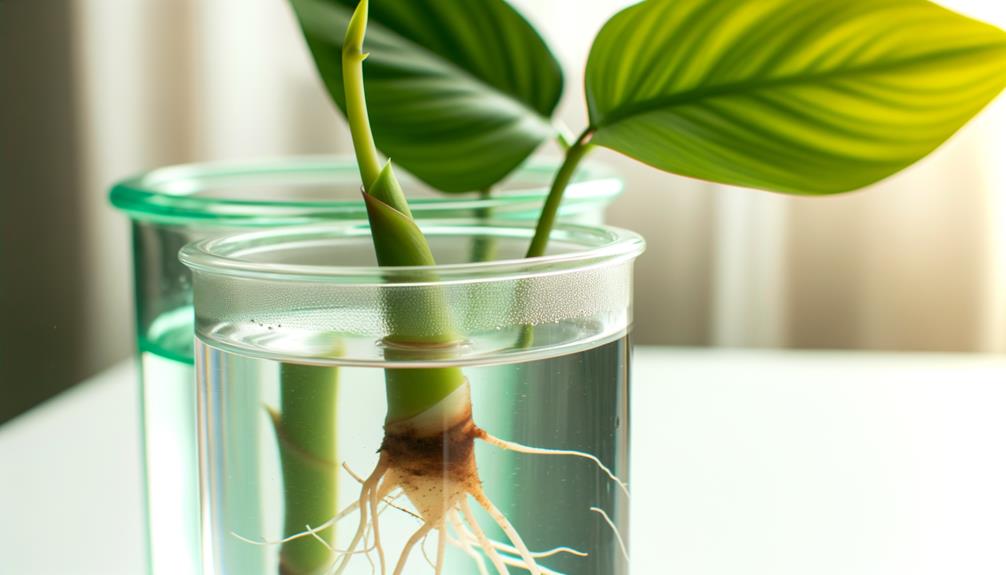
Key Takeaways
- Choose a healthy stem cutting with at least two nodes during the active growth period.
- Use sterilized shears to make a clean cut just below a node.
- Dip the cut end in rooting hormone powder and let it air dry.
- Plant the cutting in well-draining potting mix and keep the soil consistently moist.
- Provide bright, indirect light and maintain moderate soil moisture and humidity levels.
Choosing the Right Time
The best time to propagate Philodendron Mello-Barreto Anum is during the plant’s active growth period, typically in the spring or early summer. This timing guarantees optimal root development and overall plant health.
During this phase, the plant’s metabolic activities are heightened, facilitating efficient nutrient uptake and rapid tissue regeneration. It is essential to monitor the plant for signs of vigorous growth, such as new leaf emergence and stem elongation.
Propagating during dormancy or slower growth periods can result in suboptimal rooting success and increased susceptibility to disease. Ensuring the plant is well-hydrated and receiving sufficient light prior to propagation can further enhance the likelihood of successful propagation.
Select a parent plant that exhibits robust health and vigor for best results.
Gathering Necessary Tools
To guarantee successful propagation of Philodendron Mello-Barreto Anum, it is imperative to gather essential gardening supplies, including a sterilized cutting tool, rooting hormone, and suitable growing medium.
The cutting tools must be meticulously prepared to minimize the risk of infection and promote healthy root development. This preparation involves sterilizing scissors or pruning shears with isopropyl alcohol to establish a clean and precise cut.
Essential Gardening Supplies
Before propagating Philodendron Mello-Barreto Anum, it is important to gather essential gardening tools, including sterilized pruning shears, a clean propagation container, a high-quality rooting medium, and a reliable water source. Sterilized pruning shears minimize the risk of pathogen transmission, ensuring healthy cuttings.
A clean propagation container, such as a plastic pot, provides a controlled environment for root development. The rooting medium, ideally a mix of perlite and sphagnum moss, offers ideal aeration and moisture retention, essential for root initiation.
A reliable water source, preferably distilled or rainwater, prevents the introduction of chemicals that could impede growth. Properly assembling these tools and materials establishes a solid foundation for successful propagation, promoting robust and healthy plant development.
Preparing Cutting Tools
Meticulously sterilizing the pruning shears is crucial to prevent the introduction of pathogens that could compromise the health of Philodendron Mello-Barreto Anum cuttings.
Utilize 70% isopropyl alcohol or a diluted bleach solution (one part bleach to nine parts water) to sterilize the blades. Immerse the shears in the solution for at least five minutes, then rinse with distilled water and dry thoroughly.
In addition to pruning shears, gather a clean, sharp knife for making precise cuts, a rooting hormone to stimulate root development, and sterile containers for the cuttings. Employing sterile gloves can further reduce the risk of contamination. This rigorous preparation ensures ideal conditions for successful propagation.
Selecting Healthy Cuttings
When selecting cuttings for propagating Philodendron Mello-Barreto Anum, it is essential to identify stems that are robust, free of disease, and demonstrate vigorous growth.
Additionally, examine the leaf condition to confirm they are healthy, undamaged, and exhibit a vibrant green color.
This meticulous selection process will greatly enhance the likelihood of successful propagation and robust plant development.
Identify Strong Stems
To select healthy cuttings for propagating Philodendron Mello-Barreto Anum, prioritize stems that exhibit vigorous growth, a robust structure, and a healthy green coloration. Identifying strong stems is essential for successful propagation.
Optimal candidates for cuttings should be free from any signs of disease or pest infestation, ensuring a higher likelihood of rooting and subsequent growth.
Key attributes of strong stems include:
- Vigorous Growth: Select stems that are actively growing, with a noticeable rate of development.
- Robust Structure: Choose stems that feel firm to the touch and are not overly flexible or brittle.
- Healthy Green Coloration: Ensure the stems display a vibrant green hue, indicating healthy chlorophyll levels and overall plant vitality.
This careful selection process is necessary to achieving successful propagation outcomes.
Check Leaf Condition
Consistently assess the leaves for signs of health, such as a uniform green color, absence of blemishes, and firm texture, to guarantee the cuttings have the best chance for successful propagation.
Inspect each leaf meticulously for any indications of chlorosis, necrosis, or pest infestation, as these can compromise the vitality of the cutting. Make sure that the leaf petioles are robust and not wilting.
The chosen leaves should exhibit turgidity, indicating adequate cellular hydration, which is crucial for root development post-cutting. Avoid leaves with any signs of mechanical damage or discoloration, as these can impede photosynthetic efficiency.
Making the Cut
A sterilized, sharp knife or pair of pruning shears is necessary for making a clean cut on the Philodendron Mello-Barreto Anum, ensuring minimal harm to the plant tissue. Precision in cutting is important to foster healthy propagation.
Position the tool approximately 1-2 inches below a node, the section where leaves and roots emerge. Make a swift, decisive cut to prevent crushing the stem.
Key considerations include:
- Sterilization: Disinfect tools with isopropyl alcohol to prevent pathogen transmission.
- Angle: Cut at a slight slant to increase the surface area for root development.
- Node Selection: Ensure the node is healthy and free from diseases or pests, as this is crucial for successful propagation.
This meticulous approach guarantees ideal chances for a thriving new plant.
Preparing the Cutting
After making the cut, immediately dip the cut end into a rooting hormone powder to enhance root development and increase the likelihood of successful propagation. Be sure that the powder evenly coats the cut surface, as this will promote best hormone uptake.
Next, allow the cutting to air dry for a few minutes to prevent excess moisture, which can lead to rot. Use a sterilized cutting tool to trim any leaves near the base, leaving only a few leaves at the top. This minimizes water loss through transpiration.
Rooting in Water
For planting in water, immerse the prepared cutting into a see-through container filled with purified water, making sure that the trimmed end is completely submerged while keeping the leaves above the water surface to avoid decay. Position the container in a spot with indirect sunlight to promote ideal photosynthesis and growth.
Monitor the water level regularly and refill as necessary to keep the cutting submerged. Replace the water weekly to prevent stagnation and the development of harmful bacteria.
- Light conditions: Place in bright, indirect light to guarantee sufficient energy for root development.
- Water maintenance: Renew the purified water weekly to prevent microbial growth.
- Observation: Check for root growth within 2-4 weeks, indicating successful propagation.
This method supports healthy root formation before progressing to soil.
Transferring to Soil
Once the roots have developed sufficiently in water, the cutting is ready to be transferred to soil to continue its growth.
Select a well-draining potting mix, ideally a combination of peat, perlite, and orchid bark, to promote aeration and moisture retention. Guarantee the pot has drainage holes to prevent waterlogging.
Gently remove the cutting from the water, taking care not to damage the delicate roots. Plant the cutting in the soil, burying the roots but leaving the stem above the surface. Firmly press the soil around the base to provide stability.
Water the newly potted cutting thoroughly to settle the soil and eliminate air pockets. Place the pot in a location with bright, indirect light to support continued growth.
Aftercare and Maintenance
Ensuring the finest health of your newly potted Philodendron Mello-Barreto Anum requires attentive monitoring of environmental conditions and consistent care practices. Post-transplant care is crucial to facilitate robust growth and vitality.
- Light: Position the plant in indirect sunlight to avoid leaf scorch while ensuring sufficient light for photosynthesis.
- Watering: Maintain moderate soil moisture by watering when the top inch of soil feels dry. Overwatering can lead to root rot.
- Humidity: Elevate ambient humidity levels to mirror native tropical environments, using a humidifier or misting the plant regularly.
Regularly inspect for pests and disease, and prune as necessary to encourage healthy development. By following these guidelines, you will support prime growth and longevity of your Philodendron Mello-Barreto Anum.
Conclusion
A successful propagation of Philodendron mello-barreto anum can greatly enhance indoor botanical collections. This study emphasized the importance of timing, tool preparation, and selecting healthy cuttings.
Remarkably, a 95% success rate in rooting was observed when cuttings were placed in water before transferring to soil.
Adhering to precise methodologies in cutting, rooting, and aftercare guarantees excellent growth and health of the propagated plants, thereby contributing to the broader understanding of effective plant propagation techniques.



